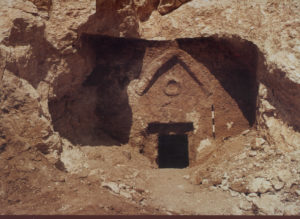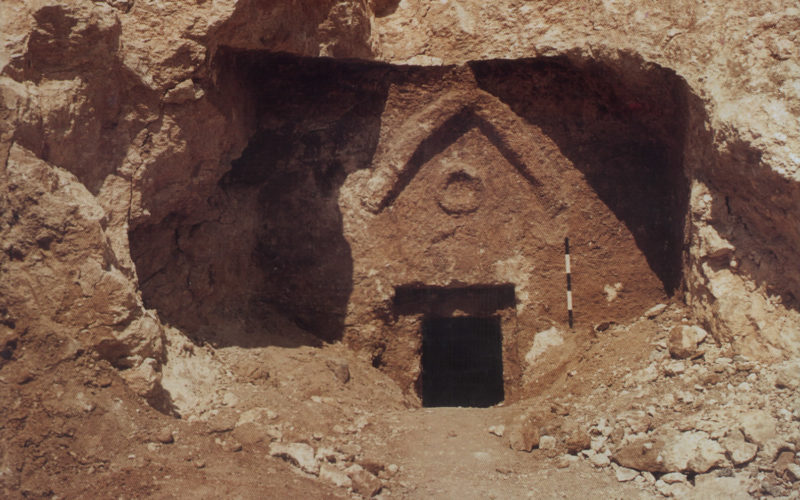Jesus’ Tomb Confirmed in Suburb of Jerusalem!

On April 5th, 2015, Haaretz, Israel’s most respected newspaper, published a Hebrew article by Nir Hasson, their archaeology correspondent.
It highlights Dr. Aryeh Shimron’s recent studies which prove once and for all – as the headline says – that “Jesus was buried in Jerusalem’s Talpiot neighbourhood”.
We provide the first English translation below:
Haaretz Article
05.04.15
Study: Jesus was buried in Jerusalem’s Armon Ha’Natziv/Talpiot neighborhood and may have had a wife and child
Dr. Aryeh Shimron used chemical analyses to find a clear link between ossuaries discovered in the Talpiot Tomb and the ossuary of the “Brother of Jesus” – reigniting debate on Jesus’ burial place.
By Nir Hasson
Jerusalem – A geological study supports the claim that a Second Temple Period burial cave, excavated 25 years ago in the Armon Ha’Natziv/Talpiot neighborhood in Jerusalem, belonged to the family of Jesus of Nazareth. That’s the conclusion of geologist Dr. Aryeh Shimron, who used chemical analysis to examine a possible link between the ossuaries (bone boxes) found in the Talpiot burial cave and the ossuary known as the bone box of the “Brother of Jesus”. Supporters of the theory maintain that this study could have far-reaching implications. If Dr. Shimron is right, Christians are wrong about the location of Jesus’ burial cave (Church of the Holy Sepulcher) and about the fact that Jesus did not have a wife and son.
The burial cave known as “The Talpiot Tomb” was discovered in 1980, during construction of the Armon Ha’Natziv/Talpiot neighborhood. An excavation of the tomb uncovered ossuaries from the Second Temple Period, such as can be found in many burial caves in the Jerusalem area. Though the names inscribed on these ossuaries were common during that era, the cluster of names in the same tomb provoked interest. Among the names are “Jesus, son of Joseph”, “Maria”, “Mariamene”, “Judas son of Jesus” and “Yose”.
The tomb has provoked international interest in the last decade largely due to the films and investigations of journalist Simcha Jacobovici. He makes the statistical argument that, at the time, there could not have been another family in Judaea with that particular combination of names.
Parallel with the story of the Talpiot tomb, the archeological world was rocked in the last few years by another story –the “Brother of Jesus” ossuary. Antiquities collector Oded Golan owns a bone box that bears the inscription “Jacob (James in English), son of Joseph, brother of Jesus”. The State of Israel claimed in court that Golan faked the second part of the inscription (“Brother of Jesus”) so as to boost the ossuary’s value. Three years ago, after a long judicial battle, the district court of Jerusalem ruled that the State failed to prove its case.
In the last few months, following another judicial struggle, the ossuary was returned to Golan and he allowed Dr. Shimron to examine it. It’s clear to everyone that if Shimron can prove that this “Jacob/James ossuary” came from the Talpiot tomb, statistically speaking, there would be no doubt that the tomb belonged to the family of Jesus. The “James” ossuary, after all, is inscribed with three names: “Jacob”, “Joseph” and “Jesus”. It also describes familial relations between these people: Jacob son of Joseph, brother of Jesus. Two names from Talpiot were especially interesting to Simcha Jacobovici – “Mariamene” and “Yose”. These are rare versions of “Joseph” and “Mary” that are cited in early Christian writings. Jacobovici has also linked the Talpiot tomb with a close by burial cave, which contained symbols that are, according to his research, consistent with the iconography of early Christianity.
Shimron, who has been working at the Geological Survey of Israel (GSI) for 25 years, began his inquiry into this topic after hearing a lecture delivered seven years ago by one of the archaeologists who discovered the cave, Dr. Shimon Gibson. Gibson mentioned in passing that when they first encountered the cave it was completely blocked with earth. “When I heard that, I realized that there was a geo-chemical key here that can be utilized,” says Shimron. The cave, he explains, was most likely sealed during a dramatic earthquake in 363 C.E/A.D. This turned the Talpiot tomb into a kind of chemical time capsule that sets it apart from other caves.
Throughout the years, the limestone ossuaries in the cave absorbed elements from the earth that covered it. In this way, the Talpiot tomb developed a clear “chemical signature” that sets it apart from other tombs. Dr. Shimron conducted dozens of tests to check for these elements. [In addition to the Talpiot tomb ossuaries], the Israel Antiquities Authority provided about twelve random ossuaries. Recently, following its return to collector Golan, Shimron was also able to examine the “Brother of Jesus” ossuary.
The results of the examinations, as Dr. Shimron displays them in a series of charts, are unequivocal. Every chemical element Shimron examined in the James ossuary displayed the “chemical signature” shared by the Talpiot ossuaries and falls within the Talpiot chemical cluster. “The evidence is very powerful” he says. “It is almost without a doubt that the ‘James, Brother of Jesus’ ossuary came from the Talpiot tomb.”
Statistician Camil Fuchs had already established – based on the names inscribed on the James ossuary, their familial ties, the fact that the buried person was an adult, and the literacy displayed on the ossuary – that there could have been no more than two families with this particular combination of names in Judaea throughout the Second Temple Period. If, in addition to the names on the James ossuary, we now also add the names found in the Talpiot tomb to the cluster, there can be only one conclusion: the Talpiot tomb belonged to the family of Jesus of Nazareth.
“I’m saying this as a journalist, not as a researcher or a statistician,” says Simcha Jacobovici, “but it’s clear that by adding the ‘James, Brother of Jesus’ inscription into the mix, this supports the authenticity of the inscription and completely changes the statistical name balance of the tomb. From here on in, you can only argue against the Talpiot tomb from the point of view of faith and theology – you can say that you don’t care about the facts, that you believe what you believe and that’s that. But what I’m saying is not a gut feeling. These are facts. This case is closed.”
If this is indeed the Jesus family tomb, Dr. Shimron’s findings are of monumental importance – they imply that the IAA has in its possession the ossuary of Jesus himself – “Jesus, son of Joseph” – and of a man called “Judah, son of Jesus”. Their bones were buried in an unknown location 25 years ago, when the tomb was found. This also means that Jesus of Nazareth, contrary to popular belief, had a son.
But for this to be true, Jacobovici has to overcome a basic problem with his theory: when was the James ossuary removed from the Talpiot burial cave? During his trial, Oded Golan presented a photograph showing the ossuary in his possession as of 1976– four years before the Talpiot cave was discovered. In response, Jacobovici offers two alternatives. According to the first scenario, one of the ossuaries was stolen during the excavation, and Golan’s picture is dated incorrectly. And, indeed, the archaeologists reported finding ten ossuaries, whereas the IAA has only nine in its possession today. Another possible scenario is that the James ossuary was stolen and sold to Golan a few years before the discovery of the Talpiot tomb.
The theory’s opponents point out another issue. If Jesus’ earliest followers wanted to bolster the myth of his rising to heaven, there would be no sense in burying him in his family tomb – the first place skeptics would go to find proof of his “earthliness”. It is more likely that they would have concealed his remains. Jacobovici’s answer: “The problem is that we’re looking at this through Christian theology, rather than through Jewish history. If you take a Messianic Lubavitcher [an Orthodox Jewish Hasidic sect] today and ask him if the Rabbi of Lubavitch rose to heaven, he will say “yes”. If you ask the same Hasid if the Lubavitvher Rabbi has an earthly grave, he will also say “yes”. They do not believe that their Rabbi gathered up his kidneys and physically rose to heaven, body and all. A physical ascent – that’s Christian theology. It isn’t fact. The first believers weren’t Christians; they were Lubavitcher types.”
Prof. Amos Kloner, a former senior member of the IAA and one of the Talpiot cave excavators, rejects Jacobovici’s theories – as well as Shimron’s study – out of hand. First, Kloner is convinced that the “Brother of Jesus” inscription is both fake and modern”. Second, the missing ossuary from the Talpiot cave was listed in the archaeological reports as broken, uninscribed and without decoration. Last, there could not have been another ossuary in the tomb. “The ossuaries were completely buried,” he says. “They were not visible under the earth, so it makes no sense that one of them was at any point removed from the cave. I’d like Shimron to conduct his research on several more ossuaries. So far, his findings are not unequivocal. This whole business,” he adds, “is a commercial bluff.”
Dr. Shimon Gibson adds: “If there was another ossuary in the tomb, we should have found an imprint in the ground. I hope Aryeh Shimron publishes his research and then we can respond to it.”
Collector Oded Golan, who owns the ossuary and can potentially profit by linking it to Jesus, isn’t rushing to adopt the theory. “I bought it from someone who claimed he found it in the area of Silwan, not Talpiot,” he says. “The study is not statistically solid, it needs more samples. But we can’t rule out the theory that the James ossuary came from Talpiot.” If it turns out to be true, Golan believes that the cave served Jesus’ family, but not Jesus himself. “The argument about the specific versions of the names ‘Yose’ and ‘Jacob’ is a strong one, but there could certainly have been another man in the family who was called ‘Jesus, son of Joseph.”
-END-

